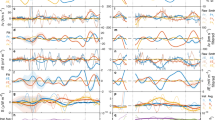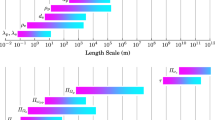Abstract
The buffetting of the magnetosphere by the solar wind is the cause of many phenomena in the magnetosphere and the ionosphere, and affects the way in which we observe many other features. Examples of magnetospheric phenomena caused, wholly or in part, by solar wind pressure variations include cavity and field-line resonances (e.g., [1], [2]), travelling convection vortices [3], ring current particle diffusion [4], quasi-periodic emissions [5], and possibly substorm onsets (e.g., [6]; but see [7]) and magnetopause reconnection [8]. Examples of the way in which solar wind pressure variations affect the way we observe and interpret magnetospheric features include the structure of the magnetopause boundary layer [9] and possibly some FTE identifications [10], and similarly the structure of the magnetotail.
Access this chapter
Tax calculation will be finalised at checkout
Purchases are for personal use only
Preview
Unable to display preview. Download preview PDF.
Similar content being viewed by others
References
Allan, W., White, S.M., and Poulter, E.M. (1986) Impulse-excited hydromagnetic cavity and field-line resonances in the magnetosphere, Planet. Space Sci, 34, pp. 371–385
Kivelson, M.G., and Southwood, D.J. (1986) Coupling of global magnetospheric MHD eigenmodes to field line resonances, J. Geophys. Res., 91, pp. 4345–4351
Friis-Christensen, E., McHenry, M.A., Clauer, C.R., and Vennerstrom, S. (1988) Ionospheric traveling convection vortices observed near the polar cleft: a triggered response to sudden changes in the solar wind, Geophys. Res. Lett., 15, pp. 253–256
Walt, M. (1994) Introduction to geomagnetically trapped radiation. Cambridge University Press.
Coroniti, F.V., and Kennel, C.F. (1970) Electron precipitation pulsations, J. Geophys. Res., 75, pp. 1279–1289
Kokubun, S., McPherron, R.L., and Russell, C.T. (1977) Triggering of substorms by solar wind discontinuities, J. Geophys. Res, 82, pp. 74–86
Henderson, M.G., Reeves, G.D., Belian, R.D., and Murphree, 1.S. (1996) Observations of magnetospheric substorms occurring with no apparent solar wind/IMF trigger, J. Geophys. Res., 101, pp. 10773–10791
Song, Y., and Lysak, R.L. (1994) Alfvénon, driven reconnection and the direct generation of the field-aligned current, Geophys. Res. Lett., 21, pp. 1755–1758
Hapgood, M.A., and Bryant, D.A. (1992) Exploring the magnetospheric boundary layer, Planet. Space Sci., 40, pp. 1431–1459
Sibeck, D.G. (1990) A model for the transient magnetospheric response to sudden solar wind dynamic pressure variations, J. Geophys. Res, 95, pp. 3755–3771
Chapman, S., and Ferraro, V.C.A. (1930) A new theory of geomagnetic storms,Nature, 126, p. 129
Mead, G.D., and Beard, D.B. (1964) Shape of the geomagnetic field solar wind boundary, J. Geophys. Res., 69, pp. 1169–1179
Smit, G.R. (1968) Oscillatory motion of the nose region of the magnetopause, J. Geophys. Res, 73, pp. 4990–4993
Yumoto, K., and the 210° MM Magnetic Observation Group (1996) The STEP 210° Magnetic Meridian Network Project, J. Geomag. Geoelectr, 48, pp. 1297–1309
Lepping, R.P., et al. (1997) The Wind magnetic cloud and events of October 18–20, 1995: Interplanetary properties and as triggers for geomagnetic activity, J. Geophys. Res, 102, pp. 14049–14063
Russell, C.T., Ginskey, M., Petrinec, S., and Le, G. (1992) The effect of solar wind dynamic pressure changes on low and mid-latitude magnetic records, Geophys. Res. Lett, 19, pp.1227–1230
Farrugia, C.J., Freeman, M.P., Cowley, S.W.H., Southwood, D.J., Lockwood, M., and Etemadi, A. (1989) Pressure-driven magnetopause motions and attendant response on the ground, Planet. Space Sci, 37, pp. 589–607
Russell, C.T., and Ginskey, M. (1993) Sudden impulses at low latitudes: Transient response, Geophys. Res. Lett., 20, pp.1015–1018
Freeman, M.P., Freeman, N.C., and Farrugia, C.J. (1995) A linear perturbation analysis of magnetopause motion in the Newton-Busemann limit, Ann. Geophys, 13, pp. 907–918
Roelof, E.C., and Sibeck, D.G. (1993) Magnetopause shape as a bivariate function of interplanetary magnetic field Bz and solar wind dynamic pressure, J. Geophys. Res., 98, pp. 21421–21450
Busemann, A. (1933) Flüssigkeits and gasbewegung, Handwörterbuch der Naturwissenschaften, Vol. IV, 2nd edition, p. 244
Hayes, W.D., and Probstein, R.F. (1966) Hypersonic Flow Theory, Vol. 1. Academic Press, New York.
Willis, D.M. (1964) The sudden commencement and first phase of a geomagnetic storm, J. Atmos. Terr. Phys., 26, pp. 581–602
Song, P., Elphic, R.C., and Russell, C.T. (1988) ISEE 1 & 2 observations of the oscillating magnetopause, Geophys. Res. Lett, 15, pp. 744–747
Author information
Authors and Affiliations
Editor information
Editors and Affiliations
Rights and permissions
Copyright information
© 1998 Springer Science+Business Media Dordrecht
About this chapter
Cite this chapter
Freeman, M.P., Farrugia, C.J. (1998). Magnetopause Motions in a Newton-Busemann Approach. In: Moen, J., Egeland, A., Lockwood, M. (eds) Polar Cap Boundary Phenomena. NATO ASI Series, vol 509. Springer, Dordrecht. https://doi.org/10.1007/978-94-011-5214-3_2
Download citation
DOI: https://doi.org/10.1007/978-94-011-5214-3_2
Publisher Name: Springer, Dordrecht
Print ISBN: 978-94-010-6195-7
Online ISBN: 978-94-011-5214-3
eBook Packages: Springer Book Archive




